When Will Kaiserriech Be Up Again
On Dominicus, April 19, 2019, Kaiser Wilhelm Ii returned from his long exile to reclaim his throne. By which I mean to say that Kaiserreich: Legacy of the Weltkrieg, the extremely popular mod for Paradox Interactive's World War 2 grand strategy game Hearts of Atomic number 26 4, has been updated for the game'southward latest patch and is again playable.
For the unacquainted, Kaiserreich is an alternate history total conversion modernistic that takes place in a world in which Germany is victorious in the Beginning Earth State of war. Originating in Hearts of Iron II, the modernistic has existed in various incarnations throughout the serial in the past decade. With an over xxx,000 strong subreddit, and an active discord community, it has an incredibly dedicated fanbase — many of whom eschew the base of operations game and play just Kaiserreich — creating fanart, fiction, AARs, and a flood of in-joke memes.
Recently, the developers accept even launched a community store where you can purchase merch, and have plans to apply that as a launching pad to produce animated original shorts set in the mod's universe. At this point it has become a veritable institution in the larger, heavily mod-focused Paradox Interactive community, but, whereas many successful HOI4 total conversion mods are based on some existing IP — Former World Blues, a Hearts of Iron IV mod based on the Fallout universe is a adept case of this — Kaiserreich is an original piece of work, and one that has even spawned its own collection of spin-off mods based on the universe the developers have created.
This article was originally published in April 2019.
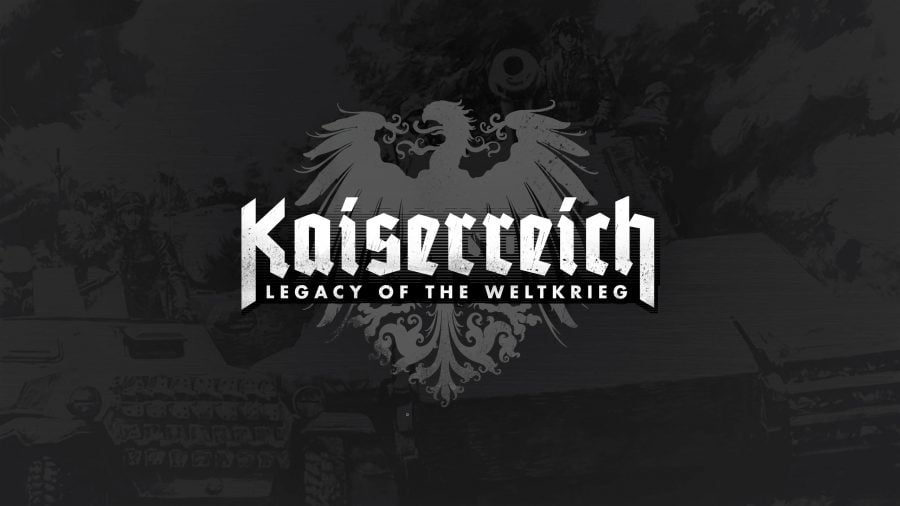
One sure sign of the mod's success is that its popularity prompted Paradox to include their own "version" in the base game by giving Germany an optional path that allows you to expel the Nazis past force and found a military machine junta which, in turn, recalls the deposed Kaiser Wilhelm Two from exile. The attempt, while admirably washed and fun in its ain right, fails to capture the magic of the mod's universe.
Kaiserreich uses its alternating-history setting to recraft the inter-war earth
Which begs the question: what is the essence of Kaiserreich'due south success? Why has the mod survived multiple incarnations over more than a decade? As someone who has played hundreds of hours of both the base of operations game and the modern, I believe this success, particularly in the Hearts of Iron IV incarnation, tin can be found in some structural issues with the base game that this mod has been effective at resolving.
Particularly, the design choices that guide Hearts of Iron limit the narrative choices available to the player, while Kaiserreich uses its alternate-history setting to recraft the globe and add a level of dynamism that but doesn't exist in the base of operations game.
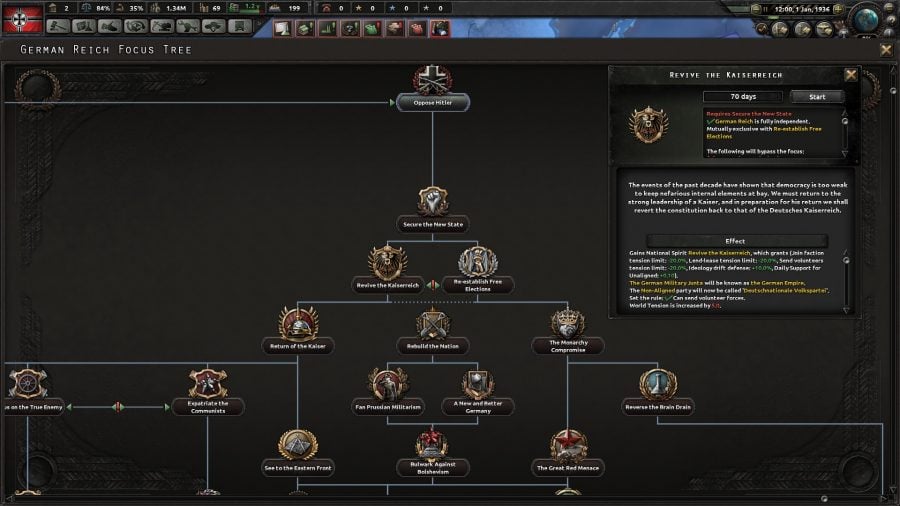
Historical Allegiance vs. Player Choice
I try to stay away from World State of war 2 games. The period is, by far, the most well-trod basis in wargaming, and in history in general for that matter. More ink, screen time, and imitation claret has been spilled on the topic than well-nigh other historical conflicts combined. Despite becoming a scrap hackneyed, Hearts of Iron IV does a serviceable chore of making the menstruation experience fresh through the use of its National Focus system, which allows yous to direct your nation down a series of branching paths through armed forces, economic, and political choices. This system is the Hearts of Iron 4 answer to the primal design dilemma in well-nigh one thousand strategy games: the delicate residue betwixt a desire for historical realism and a want for actor option.
Choose your path: Read our Hearts of Iron 4 DLC guide
In all of Paradox Interactive'due south mainline m strategy titles, this balancing act is present. At longer timescales, this problem is solved past a combination of genericizing certain celebrated events (for example the Protestant reformation in Europa Universalis 4 is an outcome that can happen later a certain time just will happen semi-randomly within a geographic area; this isn't the Protestant Reformation, it is a Protestant Reformation). Other times, the engineering science required to accept sure deportment volition exist time-locked, unable to appear until a ready year or require plenty research points that information technology volition merely happen roughly effectually when it did historically. The to the lowest degree intuitive method is to have set historical events that fire off at a particular date.
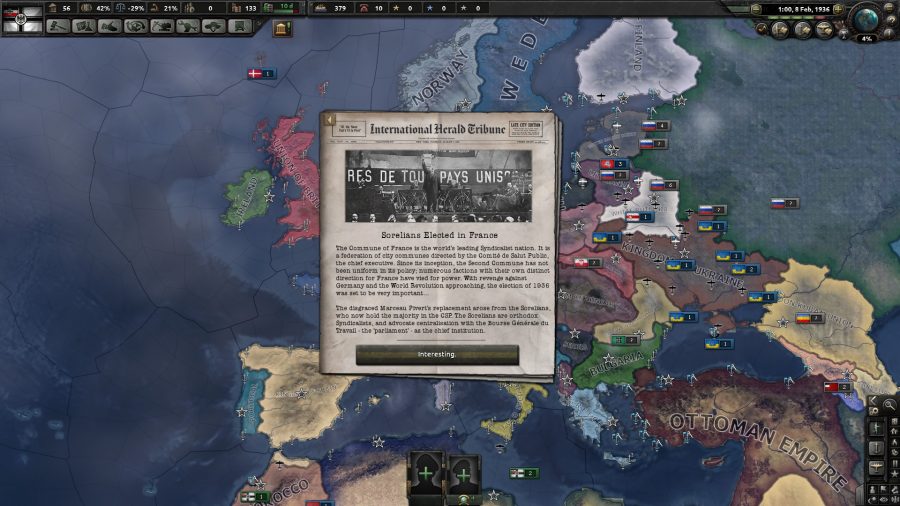
The problem with this approach is that information technology becomes more difficult at smaller timescales. In Europa Universalis or Crusader Kings 2 there are hundreds of years of game time, and so as long as they convey a general sense of the period, well-nigh players yet feel like they are experiencing a satisfying level of verisimilitude while too believing their choices matter and effect the earth around them.
The base game is choreographed and counterbalanced to play out historically
In Hearts of Iron iv, the real meat of the game happens over the course of only about a decade, and of that time, only the choices in nearly the beginning five years will have any very meaningful bear on on the limerick of the war equally a whole. This severely condenses the possibilities of player pick, as all 3 of the methods mentioned above used to create opportunities for player choice at a macro-level are rolled into the game'southward National Focus system.
This system is designed to requite the player agency, simply to do so in a controlled fashion that allows the game to maintain its tempo and keep the world on a more often than not historical track. Through the use of this system, the game is choreographed and most effectively balanced to play out historically, with the major powers striking all the major menstruum landmarks on the road to state of war. There is an option to leave historic National Focuses on, forcing the AI to get downward the path each nation did historically, or the role player tin plough this off and let each nation the possibility of going downwardly a weirder path and slightly throwing a wrench into the mix.
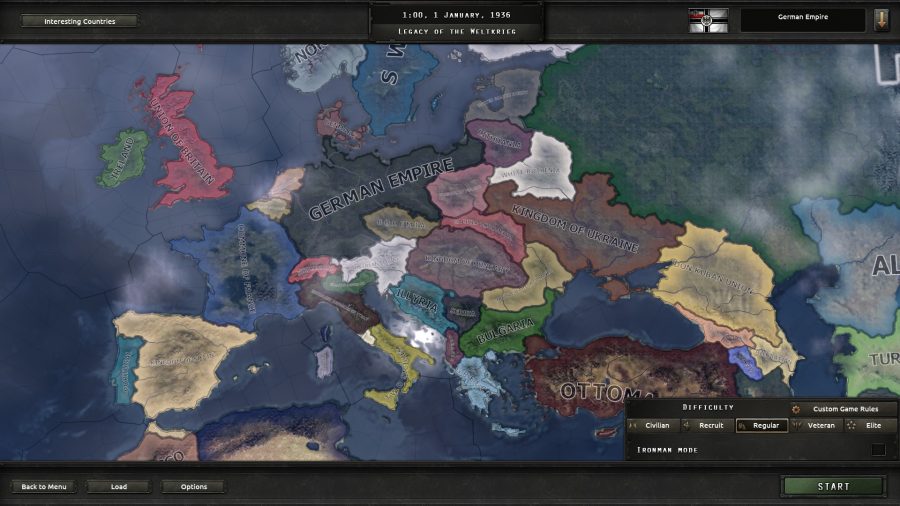
Even so, nations taking ahistorical routes can upshot in some strange hiccups, as players must sacrifice a caste of the tempo. Factions going down dissimilar routes interrupt the game's careful timing, occasionally resulting in handicapping the side that diverged historically.
In the aforementioned branch of the Germany tree that allows you to reinstall the Kaiser, for example, the player volition observe themselves at a disadvantage as they have wasted valuable time and resources fighting a ceremonious war instead of mobilizing the economic system for the coming struggle.
Play information technology cool:Read our review of HoI4's premier Common cold War modern
Frustratingly, in the end, even if the player diverges a bit historically, the overall makeup of the disharmonize volition virtually likely exist recognizable enough to anyone with a passing knowledge of the Second World War. Unless something actually foreign happens there will still be Allies.
There will be an Axis. France will probably fall. The Soviet Union will probably be invaded. Successive playthroughs will vary, only overall the story volition remain the aforementioned and on a yard strategic level, the conclusion environment volition simply modify slightly, something which has always grated on me in a conflict that those in America, Europe, and elsewhere are brought upward to know so very much about.
This is both a design issue and a narrative one, and one which has no articulate answer to resolve. The blueprint of the game pulls the "story," such equally it is, in a particular direction. In a purely operational or tactical game, this would exist less of a problem, as those types of games live and dice in the micro-level decisions, but in a chiliad strategy game, a feeling of repetitiveness at the very highest macro-levels tin can get out a player feeling like they are going through the motions of a conflict they already know inside and out.
In the Kaiserreich universe, the Wilsonian Europe of our timeline is replaced with a Wilhelmine one
Kaiserreich attacks this trouble at the root by unshackling the world from the historical record in 1917. From that point of difference, the developers created a rich, well-researched, and lovingly crafted world that retains an air of historical allegiance without requiring the game to be chained to the historical reality of our inter-war globe. Conspicuously, a large office of the success of the modernistic comes from this fact: it is an interesting scenario interestingly realized. I notice it is all-time to look at the world of Kaiserreich and its lore as a well-researched, historically possible (though hardly plausible) scenario designed for maximum entertainment value. Whereas Hearts of Fe walks a delicate tightrope between fidelity and pick, the Kaiser has his cake and eats it likewise.
In the Kaiserreich universe, the Wilsonian Europe of our timeline is replaced with a Wilhelmine 1 in which the German Empire reigns supreme as the undisputed hegemon of a great central European empire strung together with a collection of eastern customer states. The Empire also rules over an enormous and contiguous African colony, Mittelafrika, and is the reigning colonial master of a patchwork domain of southeast and eastward Asian protectorates, including a vast Chinese trading conglomerate.
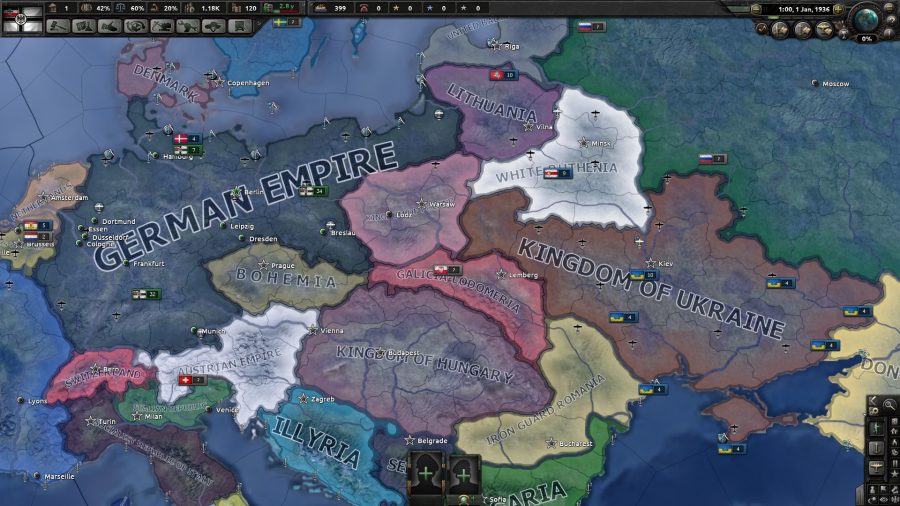
All these states are tied into Germany'due south mutual defence alliance: the Reichspakt. Frg is extraordinarily powerful but also spread incredibly thin. It must concur together the condition quo, whatever the toll, even if that means overcommitting in far-flung colonies. Austria-hungary, the other major victorious Central Power, has survived intact and remains exterior Federal republic of germany's armed services orbit. Rather than looking outward, the Habsburg domains are, at the games starting time, about to undergo a major consolidation process led from either the center-left or center-right.
Make history:Read our Hearts of Iron 4 tutorial
In the west, Uk and France accept fallen to workers' revolutions and communist governments now sit in London and Paris — their political and military alliance is known every bit the Tertiary International. Unlike in our own timeline, however, French syndicalism, not Russian bolshevism, is the preeminent ideology of the world's left-wing revolutionaries. The faction is also allied with the Socialist Republic of Italy, which took control of the n of that country later Victor Emmanuel's Kingdom fragmented after the state of war. The former British, French, and Italian governments take fled to Canada, Algeria, and Sardinia, respectively. From there, the Entente, the 3rd major faction in the modern, stews and broods, opportunistically waiting for a moment of chaos to reclaim their homelands and restore what they believe to be legitimate rule.
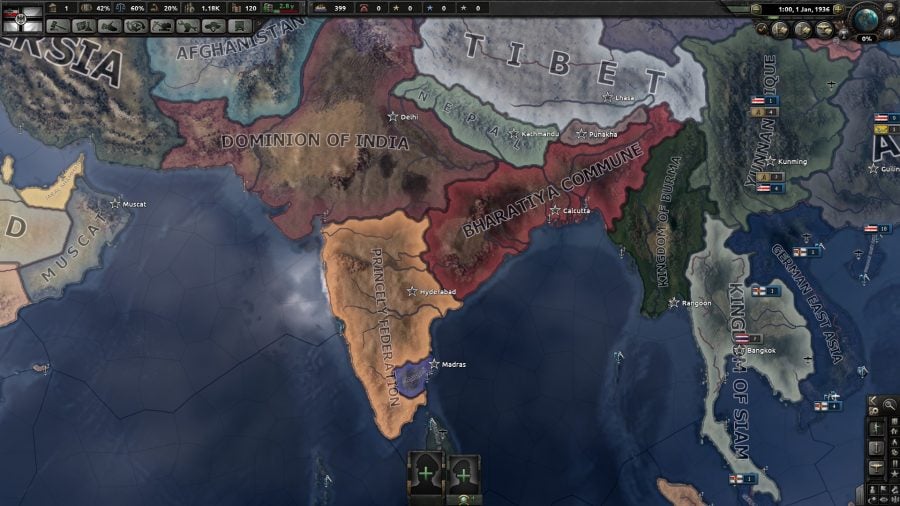
For many, this is the primary appeal of Kaiserreich. You inhabit a world which is superficially similar to the i we all know and so well — there are three major factions, one is communist, Germany leads some other, Britain and France still carry the imprint of the Entente from the terminal state of war — but at the same fourth dimension, it reflects a earth of radically dissimilar possibilities, a foreign funhouse mirror of our own historical reality, distorted simply still ultimately recognizable. It is also a earth that is ready to represent a 3-fashion conflict in which all three of the major factions are competing confronting each other for command of the aforementioned territory. The narrative conflict at the heart of the mod is best summed up by the iii taglines of these factions: Guard the Balance, Break the Chains, Reclaim the Birthright.
The developers have put bizarrely interesting historical characters into positions of power
The unshackling of the game from the historical record likewise opens up the possibilities that the writers of the lore demand not remain appreciative to the limitations of the history when crafting the geopolitical landscape. So long as the earth remains possible, and rooted in an overarching historical justification, the world can be crafted into an surround that makes for the most interesting experience possible.
Areas of the world that, in our timeline, remain tranquility and peaceful, can exist made dynamic and interesting.
Additionally, past making the mod diverge from actual history the developers have been able to mine the historical record for bizarrely interesting characters and place them into positions of ability, people like the White Russian officer Roman von Ungern-Sternberg, the Hapsburg "Ruby Prince" Wilhelm, American demagogue Huey Long, failed fascist leader Oswald Mosley, and Manchurian warlord Zhang Zuolin. Where all these characters failed historically, Kaiserreich dredges them upwards into the games gonzo-historical wonderland of wild possibilities and sets them loose against each other.
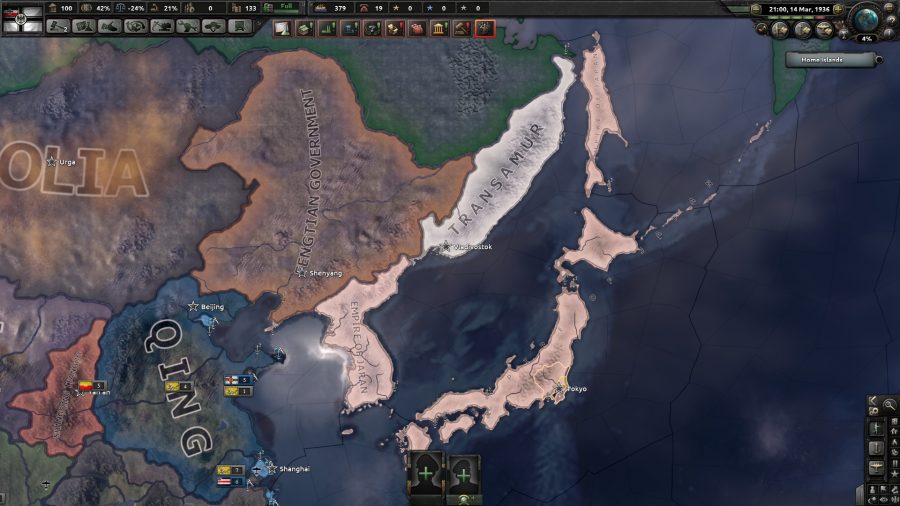
THE Gear up-PIECES
Past jettisoning the actual world of 1936, the mod can likewise have considerably more set-piece secondary struggles that precede the coming Earth War, like to the Castilian Civil War in our own timeline.
In the Kaiserreich universe, however, virtually every region has some similar kind of struggle — in that location is a three-way Spanish civil war, a too-many-sides-to-count American civil war that can elevate in other factions, an Arabo-Persian coalition to accept down the lumbering Ottomans, a Fourth Balkan War, an Argentine Civil War, a competition for control of the Indian sub-continent, the possibility of revolutions in both French and German language Africa, besides every bit in German Indochina.
20th Century foxholes: Read our guide to the best WW2 games
The allure of Kaiserreich is that information technology takes a game based on a largely bipolar war and makes information technology maddeningly multi-polar. Some of the above-mentioned events won't happen every game, others will fizzle out or end quickly in a decisive victory, and in that uncertainty, that dynamic and chaotic world, is where the success of Kaiserreich lies.
These ready-pieces burn off at a steady clip, and then that even if one office of the world is quiet, you tin can gawk at the unfolding chaos somewhere else or participate past sending volunteers to aid the side that has a possibility of benefiting your faction. Turning the tide in one of these struggles might just allow you to open upwardly a new flank or prevent one from opening behind yous. The sheer number of these set-pieces, combined with the wide range of ideological paths and sub-paths given to most large nations, means that the map hardly e'er looks the same fashion twice.
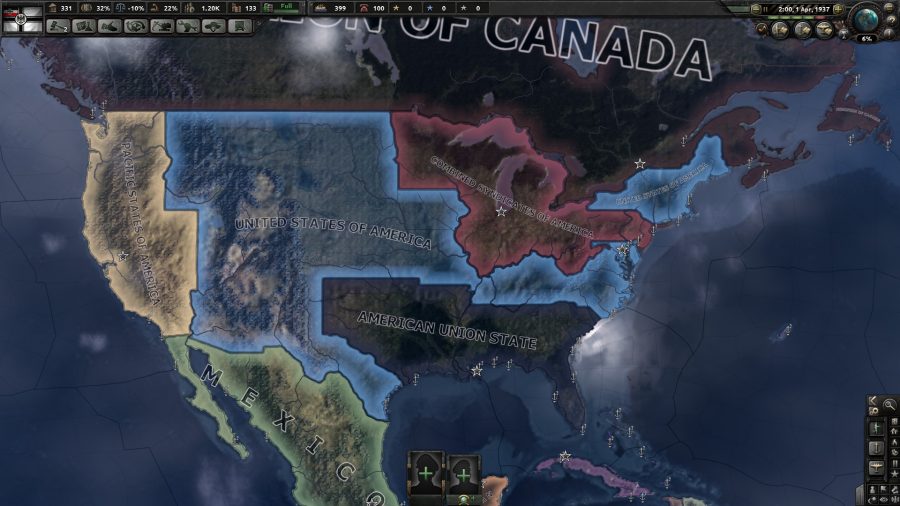
The Wildcard Powers
Similar in the base game, though, the looming and inevitable World War provides the meat of the games overarching narrative. A revanchist France will inevitably confront an overstretched Frg.
A groomed war can rubber-ring back to balance once one of the wildcards joins the fray
What makes the modernistic'due south version of the 2d World War more engaging is that while both are titanic struggles, the 2d Weltkrieg is aided by both the in a higher place mentioned set-pieces, which get out the world dynamic and uncertain, riddled with geopolitical landmines, and the fact that the late game is improved considerably past a number of large wildcard powers that spend most of the early and middle game consolidating before ultimately entering to assistance sway the balance in the Second Weltkrieg, namely Austria-Hungary, Russia, and the United states.
After each of their respective consolidations, each has options to enter the war and attempt to tip the remainder or take advantage of the ensuing chaos. Whereas in the base game one time the tide turns and 1 side gets a clear reward the rest of the game becomes a long slog of mopping up and intractable foe, in Kaiserreich, a articulate-cut war can safe-band back to balance in one case one of the wildcards tosses their weight into the fray.
All of these factors — the expertly realized alternate timeline, the interesting characters, the introduction of more set-piece struggles and wildcard factions — combine to create a game that is fundamentally more dynamic than the base of operations game on which information technology was built. This dynamism makes each playthrough much more varied and therefore, about importantly, more than replayable than the base game.
This is not chaos for chaos' sake, however. The world of Kaiserreich incorporates this dynamism into the greater narrative of the game, demonstrating how rising instability tin can undermine a global order, no matter how firmly entrenched it appears from the outside. Information technology is a story of the end of a moment and the ascent of revanchist and opportunist powers. It is a story that resonates far more with our own time than does the actual 2d World War.
As in existent history, the oil fields of Azerbaijan and Romania go essential
If any of this has piqued your interest, I suggest y'all take a swoop into the newly updated version compatible with the games latest Ironclad update. The introduction of fuel mechanics can throw a wrench into several of the faction'due south carefully laid plans. As in bodily history, the oil fields of Romania and Azerbaijan become nearly essential to agree to go along the state of war machines of the European powers running, further stretching Germany's political commitments, while more than accurately representing the fuel difficulties Britain and France would have if they were severed from their overseas holdings. It adds another layer of realism into a game in which logistics are largely bathetic. Bank check it out. This is a modernistic that is well worth your time.
For a break-down of Hearts of Atomic number 26 4'due south other must-have mods, as well every bit a quick introduction to getting started in the modded game, make sure you check out our guide to the best Hearts of Iron 4 mods.
Source: https://www.wargamer.com/hearts-of-iron-4/mod-kaiserreich
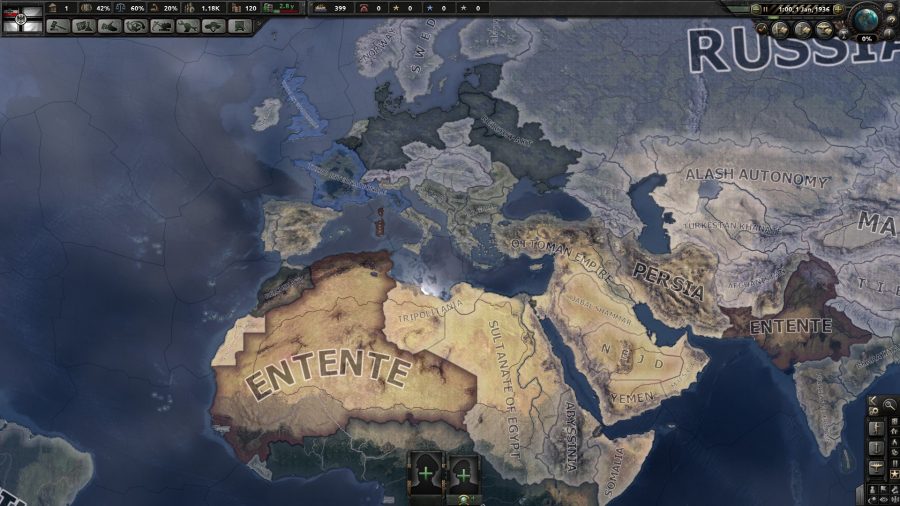
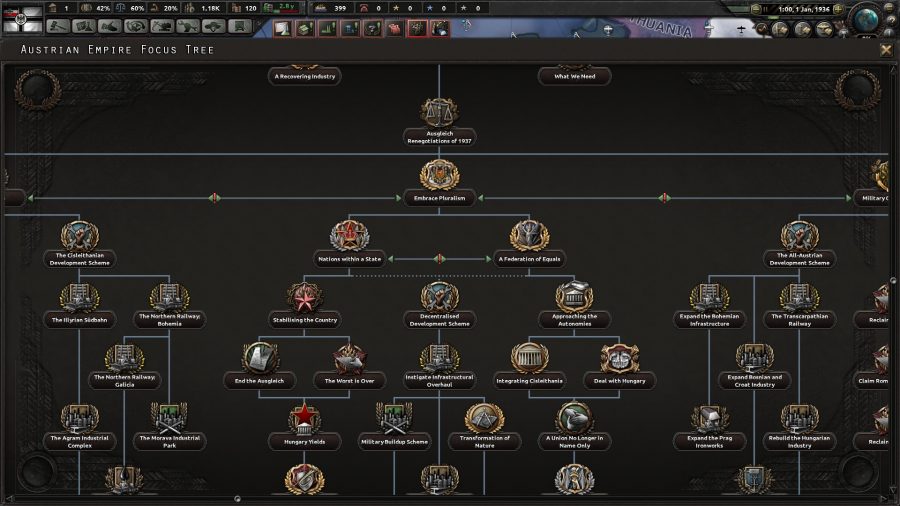
0 Response to "When Will Kaiserriech Be Up Again"
Post a Comment